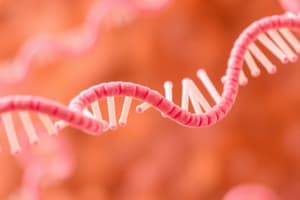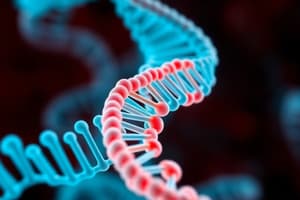Podcast
Questions and Answers
During gene expression, what is the correct order of information flow as described by the central dogma?
During gene expression, what is the correct order of information flow as described by the central dogma?
- DNA -> RNA -> Protein (correct)
- DNA -> Protein -> RNA
- RNA -> DNA -> Protein
- Protein -> RNA -> DNA
The central dogma applies to all known biological systems without exception.
The central dogma applies to all known biological systems without exception.
False (B)
What enzyme is responsible for transcribing DNA into RNA?
What enzyme is responsible for transcribing DNA into RNA?
RNA polymerase
After transcription, an RNA molecule undergoes several processing steps to become a mature __________ RNA (mRNA).
After transcription, an RNA molecule undergoes several processing steps to become a mature __________ RNA (mRNA).
Match the following components of the central dogma with their primary function:
Match the following components of the central dogma with their primary function:
What is the primary role of ribosomal RNA (rRNA) within the cell?
What is the primary role of ribosomal RNA (rRNA) within the cell?
All RNA molecules undergo the same processing steps to become mature mRNA, regardless of whether they code for proteins.
All RNA molecules undergo the same processing steps to become mature mRNA, regardless of whether they code for proteins.
Where does the synthesis and processing of rRNA primarily occur within the cell?
Where does the synthesis and processing of rRNA primarily occur within the cell?
Mature mRNA binds to a ______ receptor to be guided through the nuclear pore complex into the cytosol.
Mature mRNA binds to a ______ receptor to be guided through the nuclear pore complex into the cytosol.
Match the following non-coding RNAs with their respective functions:
Match the following non-coding RNAs with their respective functions:
Which of the following best describes the function of RNA polymerase?
Which of the following best describes the function of RNA polymerase?
In eukaryotes, a single type of RNA polymerase is responsible for transcribing all types of RNA.
In eukaryotes, a single type of RNA polymerase is responsible for transcribing all types of RNA.
What is the primary function of general transcription factors in eukaryotic transcription?
What is the primary function of general transcription factors in eukaryotic transcription?
In prokaryotes, the signal that causes RNA transcription to stop is called a(n) ________.
In prokaryotes, the signal that causes RNA transcription to stop is called a(n) ________.
Match the RNA processing event with its description:
Match the RNA processing event with its description:
Which of the following is the correct order of events in pre-mRNA processing in eukaryotes?
Which of the following is the correct order of events in pre-mRNA processing in eukaryotes?
The primary purpose of adding a poly-A tail to eukaryotic mRNA is to prevent its degradation in the cytoplasm.
The primary purpose of adding a poly-A tail to eukaryotic mRNA is to prevent its degradation in the cytoplasm.
What are snRNPs and what is their role in RNA splicing?
What are snRNPs and what is their role in RNA splicing?
Flashcards
Central Dogma
Central Dogma
The flow of genetic information from DNA to RNA to protein.
RNA Polymerase
RNA Polymerase
Enzyme that transcribes DNA into RNA.
mRNA
mRNA
RNA molecule that carries genetic information from DNA to ribosomes for protein synthesis.
Ribosomes
Ribosomes
Signup and view all the flashcards
Translation
Translation
Signup and view all the flashcards
mRNA Export
mRNA Export
Signup and view all the flashcards
Ribosomal RNA (rRNA)
Ribosomal RNA (rRNA)
Signup and view all the flashcards
Nucleolus
Nucleolus
Signup and view all the flashcards
Non-coding RNAs
Non-coding RNAs
Signup and view all the flashcards
Central Dogma Overview
Central Dogma Overview
Signup and view all the flashcards
RNA Transcription
RNA Transcription
Signup and view all the flashcards
Promoters
Promoters
Signup and view all the flashcards
General Transcription Factors
General Transcription Factors
Signup and view all the flashcards
Terminator
Terminator
Signup and view all the flashcards
5' Capping
5' Capping
Signup and view all the flashcards
Introns
Introns
Signup and view all the flashcards
Poly-A Tail
Poly-A Tail
Signup and view all the flashcards
Study Notes
- Genetic information in chromosomes is converted into proteins in the cytosol.
- DNA information is first transcribed into RNA by RNA polymerase.
- RNA undergoes processing to become messenger RNA (mRNA).
- mRNA molecules are exported from the nucleus to the cytosol and translated into proteins by ribosomes.
- Some RNA molecules do not code for proteins and are processed differently.
- Transcription and translation are highly regulated and require energy to maintain high fidelity.
- Information flows from DNA to RNA to protein in prokaryotes and eukaryotes.
- Information content goes from DNA > mRNA > protein.
RNA Transcription
- Transcription generates a single-stranded RNA molecule complementary to a DNA template strand.
- RNA is synthesized 5'->3', while DNA is read 3'->5' by RNA polymerase, a complex multi-subunit enzyme.
- Eukaryotes have 3 different RNA polymerases, while prokaryotes only have one RNA pol.
- In prokaryotes, RNA polymerase strongly binds to the promoter sequence.
- Eukaryotes needs general transcription factors which position RNA polymerase and start transcription.
- Extension of the RNA chain requires elongation factors and ATP hydrolysis.
- RNA transcription stops after RNA polymerase encounters a special DNA sequence called a terminator.
- In eukaryotes, transcription ends after reaching a polyadenylation signal.
MRNA Processing
- Processing is required for RNA's that encode proteins before they are considered mRNA.
- The first modification occurs after the 5' end of RNA exits polymerase, which adds a 7-methylguanosine "cap" to the 5' end.
- Protein-coding genes contain introns (intervening sequences) that interrupt coding sequences (exons).
- Introns must be removed via RNA splicing carried out by the spliceosome.
- Spliceosome carries out RNA splicing, using small nuclear ribonucleoproteins (snRNPs), small nuclear RNAs (snRNAs) and multiple proteins.
- The spliceosome assembles while pre-mRNA is being transcribed.
- The splicing process is flexible and a given transcript may have different splicing patterns.
- Once transcription is complete, the 3' end of the RNA receives a poly-A tail.
- The 3' end of the original RNA is cleaved off and ~200 A's are added by poly-A polymerase.
- Poly-A tail involves poly-A binding proteins and is important for export from the nucleus and later protein synthesis.
- RNA synthesis and processing occur in the nucleus, while protein synthesis occurs in the cytosol.
- Mature mRNA binds to nuclear export receptor, which guides it through the nuclear pore complex into the cytosol.
Non-Coding RNAs
- mRNA represents only ~5% of cellular RNA.
- Up to 80% of cellular RNA is ribosomal RNA(rRNA) which is the structural and catalytic core of ribosomes.
- rRNA is synthesized by RNA pol I (18S, 5.8S, and 26S) and RNA pol III (5S).
- Non-coding RNAs have functions in pre-mRNA splicing (snRNAs), ribosome assembly (snoRNAs), protein synthesis (tRNAs), regulation of gene expression (siRNAs and miRNAs), telomere synthesis, and more.
RNA Types and Functions
- Messenger RNAs (mRNAs) code for proteins.
- Ribosomal RNAs (rRNAs) form the basic structure of the ribosome and catalyze protein synthesis.
- Transfer RNAs (tRNAs) transfer RNAs, central to protein synthesis as adaptors between mRNA and amino acids
- Small nuclear RNAs (snRNAs) function in nuclear processes, including pre-mRNA splicing.
- Small nucleolar RNAs (snoRNAs) are used to process and chemically modify rRNAs.
- Small cajal RNAs (scaRNAs) modify snoRNAs and snRNAs.
- MicroRNAs (miRNAs) regulate gene expression by blocking translation of selective mRNAs.
- Small interfering RNAs (siRNAs) turn off gene expression by directing degradation of selective mRNAs.
- Other noncoding RNAs function in telomere synthesis, X-chromosome inactivation, and transport of proteins into the ER.
RNA Polymerases and Genes Transcribed
- RNA polymerase I transcribes 5.8S, 18S, and 28S rRNA genes.
- RNA polymerase II transcribes all protein-coding genes, plus snoRNA, miRNA, siRNA, and most snRNA genes.
- RNA polymerase III transcribes tRNA, 5S rRNA, some snRNA genes, and genes for other small RNAs.
- The rRNAs are named according to their “S” values referring to sedimentation rate in an ultracentrifuge.
Studying That Suits You
Use AI to generate personalized quizzes and flashcards to suit your learning preferences.
Related Documents
Description
Genetic information in chromosomes is converted into proteins. DNA information is transcribed into RNA by RNA polymerase. mRNA molecules are exported to the cytosol and translated into proteins by ribosomes. Information flows from DNA to RNA to protein.




